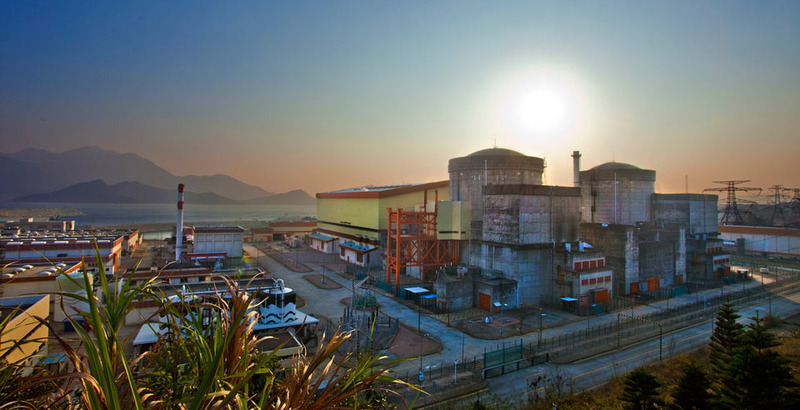Elusive particles called neutrinos are the chameleons of the subatomic world. They come in three different types or "flavors" that can morph into one another as they zip along at near-light speed barely interacting with anything else. Now, physicists working at a nuclear power plant in China have made the last measurement needed to describe those "neutrino oscillations." The result completes a conceptual picture of neutrinos and paves the way for experiments that would search for an asymmetry between the behavior of neutrinos and antineutrinos and could help explain why the universe contains so much matter and so little antimatter.
"It's not just a parameter, it's a gateway," says Robert Plunkett, a physicist at Fermi National Accelerator Laboratory in Batavia, Illinois, who works on an accelerator-based neutrino experiment called MINOS.
The three flavors of neutrinos include electron neutrinos, which are born in nuclear reactions; muon neutrinos, which emerge from the decay of particles called pions; and tau neutrinos, which have been generated in particle collisions at accelerator labs. For more than a decade, researchers have known that neutrinos oscillate between these flavors. For example, electron neutrinos born in the sun morph into other flavors before they reach Earth, so that fewer electron neutrinos arrive than would otherwise be expected. Similarly, muon neutrinos created when cosmic rays strike the atmosphere also change stripes before they rain down to the ground. Those oscillations also prove that neutrinos have mass, as they can occur only if the neutrinos have different masses.
In a variety of experiments with underground detectors, particle accelerators, and reactors, researchers had measured all but one of the parameters in a theoretical scheme to describe the oscillations: the two mass differences among the three neutrinos and three abstract "mixing angles" that, crudely speaking, describe how much one flavor mixes into another. Now, the 240 physicists working with the Daya Bay Reactor Neutrino Experiment at the Daya Bay Nuclear Power Plant and two neighboring plants in Da Peng, China, have measured the last of the three mixing angles, known as θ13. The team presented its results today at a seminar at the Institute of High Energy Physics of the Chinese Academy of Sciences in Beijing.
To nail down the last angle, researchers studied electron antineutrinos produced by the six 2.9-gigawatt reactors at the site. They measured the flux of antineutrinos using two 100-tonne detectors near the reactors and four identical detectors 1.7 kilometers away. They looked for a decrease in the rate at which the electron antineutrinos reached the far site that would signal the oscillation of the particles into the two other flavors, which the detectors could not sense. In doing so, Daya Bay researchers searched for a faster, smaller oscillation imposed on top of the longer, slower one that accounts for the disappearance of electron neutrinos from the sun, which is dominated by a different mixing angle. They found that θ13 equals 8.8 degrees.
In making a definitive measurement, the Daya Bay researchers edged out four other teams that were vying for the prize. Last June, physicists working with an accelerator-based neutrino experiment in Japan called T2K came close with measurements using a slightly different technique. Ten days later, MINOS released a similar result. In November, researchers working with the Double Chooz reactor experiment in northeastern France reported a result with large uncertainty. The RENO experiment in South Korea is also measuring the angle.
The Daya Bay team started taking data on 24 December and needed only 55 days of running the detectors to make a definite measurement. That's in part because the angle turns out to be pretty large. "I think we had maybe 3 weeks' worth of data and already we could see a significant effect," says Robert McKeown, a Daya Bay collaborator from Thomas Jefferson National Accelerator Facility in Newport News, Virginia. "We were surprised."
The fact that θ13 is not zero suggests that neutrino physics will be rich in the next decade or so. For example, it implies that there could be a slight asymmetry between neutrinos and antineutrinos—called CP violation—a slight asymmetry that might help explain why the universe evolved to contain so much matter and so little antimatter. "All these CP-violating effects vanish if θ13 is zero," says Paul Langacker, a theorist at the Institute for Advanced Studies in Princeton, New Jersey. A measurement of zero would have been bad news for researchers in the United States, Japan, and Europe with plans to build large neutrino detectors that could probe CP violation.
The result is significant for another reason, says Jefferson lab's McKeown. "This is arguably the most important physics result ever to come out of China," he says. Chinese particle physics has arrived, it seems.

New dawn. The measurement of a key parameter at the Daya Bay Nuclear Power Plant in China presages an exciting future for neutrino physics.
Credit: Roy Kaltschmidt/Lawrence Berkeley National Laboratory
(原文链接:http://news.sciencemag.org/sciencenow/2012/03/physicists-in-china-nail-a-key.html?ref=hp) |

